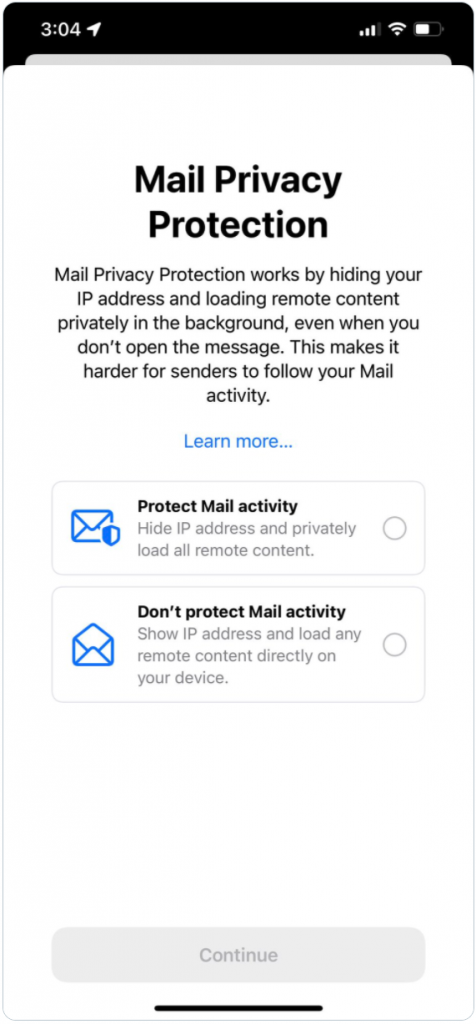Privacy vs. Deliverability: How to Navigate the Apple Mail Privacy Protection Updates

The ground has begun to move crumble beneath our feet in the email world, ever since Apple announced its new Mail Privacy Protection features in June 2021. The announcement has left email marketers concerned restless in anticipation for its upcoming release in September 2021. We can’t help but wonder — will Apple’s Mail Privacy Protection kill the open rate as a KPI?
What is Apple Mail Privacy Protection?
In case you missed it, the Mail Privacy Protection update will offer privacy protection to Apple Mail users accessing emails on the native Apple Mail application, regardless of their email address (this includes any email addresses from Gmail and Yahoo, and so on).
If an Apple Mail user opts in to privacy protection, Apple Mail will stop email senders from learning whether a user has opened an email by automatically loading all images and remote content, including the email tracking pixel. It will also hide IP addresses so that senders cannot learn a user’s location or use it to build a profile around them.
Therefore, senders will no longer know which subscribers using Apple Mail actually opened, when or where.
Why is privacy a good thing?
Privacy allows subscribers to guard who has access to their information and to what extent. Much like real-life relationships, it’s generally frowned upon to sleuth information about a friend or potential partner without them explicitly sharing consent with you. (Or just, you know, telling you themselves.)
Apple’s Mail Privacy Protection aims to place the power back in the hands of the subscriber by giving users more control over their data, and that’s a good thing. It requires (and invites) you as a sender to cultivate a more two-way and personal relationship with them by providing an opportunity to redefine how you engage with your subscribers.
How will Apply Mail Privacy impact email senders?
Because 58% of the market share for email clients is Apple Mail, it is very likely that a large portion of your subscriber base is already using Apple Mail. Although your Apple Mail subscribers will have to opt in or out of this protection, it’s likely that most will opt in due to the emphasis of the word “protect” in the language: “Protect Mail activity” or “Don’t protect Mail activity.” (Honestly, who’s going to click “Don’t protect Mail activity” when it’s put like that?)

So let’s say 100% of your subscribers are using Apple Mail and 100% are opted in to privacy protection. You can expect every email sent to them to have an open rate of 100%. (Remember, they will appear to you to have all opened, because Apple Mail will automatically load all images, including your tracking pixel).
Therefore, if your subscriber base is a blend of Apple Mail, Outlook and Gmail, then your email open rate as a whole will inflate and appear to be closer to 100%. This will make your overall open rate an unreliable source for measuring engagement — one bad Apple spoils the bunch.
What will be the biggest challenge for email senders?
Speaking openly, the Apple Mail Privacy Protection will (definitely, probably) render open data largely inaccurate for most senders. Since the open data from Apple Mail users will be skewed and inaccurate, this will in turn render the open rate metric virtually obsolete. And because open rate metrics are heavily used by email senders to measure subscriber engagement, even at times exclusively, it will make things like list hygiene and deliverability harder to maintain.
How will senders be able to measure engagement without a viable open rate?
Some have argued that Apple’s Mail Privacy Protection places a blindfold on senders who are following email best practices and using open data to send emails to their most actively engaged subscribers. Others say that the open rate is largely a vanity metric, and was already an imperfect data point for measuring a subscriber’s overall engagement.
Wherever you fall, the reality is open data will become more and more unreliable as the email industry trends positively towards privacy. That means email senders must improve how they have historically measured engagement.
And now, email senders have that opportunity.
How is this update good for senders?
There is an opportunity here for creators or senders to innovate how they engage with their email subscribers by crafting email content that subscribers can interact with more personally. There is also an opportunity for senders to use a variety of metrics to more holistically measure subscriber engagement. Let’s dive into both more below.
What is the best path forward for measuring email engagement?
A major benefit of email communication that is often overlooked by marketers is its ability to be two-way. As an email sender, you are able to hear directly from your subscribers. So without open data, email senders are still able to use clicks and reply-to data, to measure engagement. This is so much better than some stinky old open rate!
Another benefit in an email marketer’s favor is the abundance of data from your overall digital presence. Leverage your website, platform or other channel data — such as a subscriber’s last purchase date or last session date — to create a fuller picture of subscriber engagement.
Invite your subscribers to interact and engage with you.
-
Like, heart or thumbs up
- Ask your subscribers directly if they enjoyed your email. Provide a like button, a heart button or a thumbs up button in your emails and get readers’ first-hand feedback on whether they enjoyed your email or found it helpful.
- Reward your readers by adding a button that says “I Read This.” When the subscriber clicks it, it opens to a gold star badge in their account. This will help build and measure your engagement, as well as build a community of readers. It is also perfect for informational or newsletter style emails.

-
Ask your subscribers a question they can’t refuse.
- Ask your subscribers a question they can’t not answer, or something they would be tempted to indulge in, such as, “How are you preparing for the Apple Mail Privacy update in September?” or “What did you have for breakfast?” Ask your subscribers to reply to the email with their answers. You don’t have to address every single reply, but you could call out individual responses or the overwhelming majority of tips within your next email. Your readers will feel included and will look forward to your next email.
-
Use one clear call to action.
- As a good email sender, you respect how many emails your subscribers are getting on a daily basis. Subscribers don’t have time to read through blocks of text to determine what it is a sender wants from them. Dedicate one CTA for your email. Make it big and bold, easy to find, clear and something they are interested in.
-
Move the party to your website.
- If your email is informational, or newsletter style, replace larger blocks of reading, with short, high-level snippets to get the reader started. Include a “Read More” button and drive the reader to a webpage that hosts the newsletter. This way, they can finish reading the post on your website instead of within the email, where they will read through and ultimately close the email without interacting.
What is the best path forward for list hygiene?
-
Send a reconfirmation email every six months.
-
Send an email every six months asking your subscribers to re-opt in. Make the primary call-to-action very clear, such as, “Yes, I’d Like to Keep Receiving Emails.” Be sure to send it regularly and require a click. This will allow you to remove inactive subscribers based on who did not click. It will also ensure you are emailing your most engaged subscribers and protect your deliverability.
- You can also include a button that says “Pause for Now” and add those subscribers to a muted list, to be sent a reconfirmation email at a later time. This could work well for brands with customers who need to make purchases intermittently or engage based on seasonality.
-
-
Implement a preference center.
- Adding in a preference center allows subscribers to dictate their level of engagement with you. The preference center can include a list of emails based on topic or a preferred sending schedule, which allows them to determine how many times a week they want to hear from you.
-
Always put subscribers first.
- The release of the Apple Mail Privacy Protection demonstrates the importance of human-centered and conscious marketing practices and strategies. Instead of finding ways to subvert subscriber privacy, this should inspire brands to continually innovate and be creative with their approach to continue to deliver the best experience for their subscribers and customers. Nebo will certainly be putting our thinking hat on to make our emails better than they’ve ever been.

Comments
Add A Comment